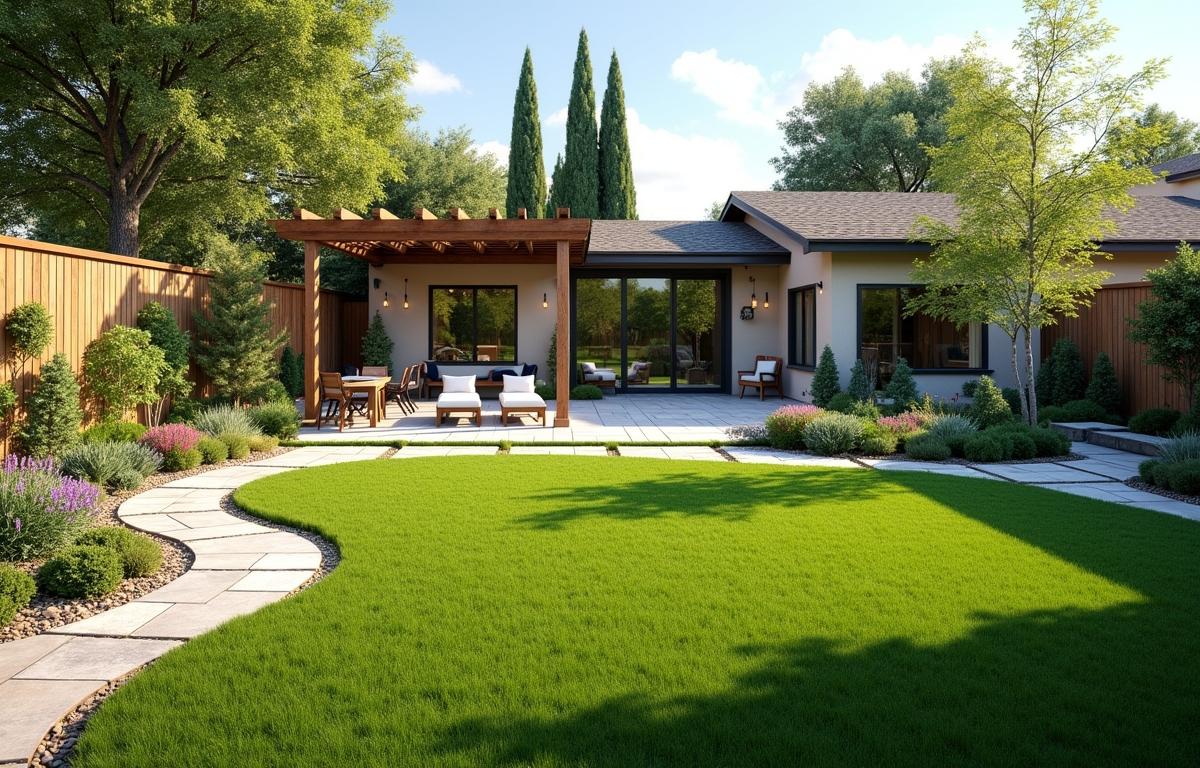Design A Landscape that adapts to your family’s lifestyle can bring years of comfort, enjoyment, and memorable outdoor moments. Whether you dream of a secluded garden retreat or a dynamic space where kids can safely explore, designing with flexibility in mind ensures your yard will evolve beside your loved ones. Balancing aesthetics, budget, and practicality requires thoughtful planning and a vision of how your outdoor space might be used in the future.
Contents
Planning for Longevity and Flexibility
A good first step in family-focused landscape architecture is analyzing your family’s most frequent outdoor activities. If you have children dedicated to sports or energetic pets, your design should accommodate open play areas. If you envision tranquil spots for reading or conversation, ensure you carve out cozy nooks with seating. These zones can coexist harmoniously when you plan circulation patterns that cater to diverse needs.
At the same time, it’s wise to factor in future changes. One day, your kids may need a space for gardening experiments, while you might want a bigger patio for extended family gatherings. Consider whether permanent structures like pergolas and stone pathways will hinder potential expansions. By maintaining a balance of fixed and flexible features, you can adjust outdoor design elements over time with minimal disruption.
Determining Your Family’s Evolving Requirements
As part of the initial landscape planning process, do a site analysis that looks at sun exposure, drainage, and soil quality. These data points help you select the right plants and materials that thrive in your specific climate and yard conditions. If you anticipate the addition of new uses—such as a vegetable patch, sandbox, or water feature—make sure you leave open zones or transitional areas where these can be placed without major rework.
Also, think about how you can support your family’s changing interests affordably. For instance, an open lawn can be repurposed as a pollinator garden or orchard years down the road. With thoughtful consideration, a single piece of land can morph into several functions over time, weaving together style, purpose, and natural beauty.
Incorporating Hardscapes and Eco-Friendly Landscaping
Hardscape design can give your yard structure in a timeless way. Retaining walls, walkways, patios, and seating areas can frame your garden layout and make high-traffic spots easy to navigate. Opt for slip-resistant pavers if you have young children zipping around. Stone, concrete, and wood can seamlessly blend with softscape elements like trees and shrubs when chosen in colors and textures that match your home’s architectural style.
Eco-friendly landscaping also aims to reduce the environmental impact of your design. Rather than sprawling lawns, consider meandering paths lined with native plants that conserve water. These choices boost local biodiversity and require less landscape maintenance. Emphasizing sustainable solutions can keep your outdoor spaces looking vibrant while making a positive mark on your community’s environment.
The Role of Garden Layout
A balanced garden layout sets the stage for an inviting and functional space. Group plants with similar needs so watering and fertilizing become more efficient. Clustering shrubs, flowers, and groundcovers thoughtfully also creates an attractive tapestry of textures and colors. This approach supports easier vegetation management, while showcasing diverse species for visual interest.
If you have multiple seating zones, ensure pathways connect them in a logical flow. That might mean a graceful curve around flowerbeds or a walkway that leads to a charming water feature. Use your garden layout to lead guests, children, and pets on a journey through various “rooms” of the landscape, each with its own purpose.
Selecting Eco-Friendly Materials
When adding features like decks or pergolas, try using reclaimed wood or composite materials for a smaller carbon footprint. Such materials require less upkeep while maintaining a natural look. If you plan to add a driveway or extended patio design, permeable pavers allow rainwater to filter into the soil, aiding drainage and mitigating runoff. Combining these innovative options with perennial plant choices enhances sustainability.
Prioritizing Plant Selection and Sustainable Practices
Choosing the right mix of greenery is essential for a yard that matures with grace. Ideally, you’ll combine hardy native species with ornamentals that reflect your aesthetic. Native plants typically need less watering and can resist local pests more effectively. This dynamic fosters less rigorous upkeep and can weather shifts in climate.
Besides focusing on water-saving species, consider xeriscaping strategies. Xeriscaping employs drought-tolerant plants such as succulents, ornamental grasses, and specific perennials. This approach reduces your reliance on irrigation systems and gives you a resilient landscape. Even if you don’t convert the entire yard into a xeriscape, using these principles in water-sensitive areas—like embankments or south-facing slopes—can lower your time and money invested in care.
Xeriscaping for Water Efficiency
Strategic grouping of low-water plants can be visually stunning. Use mulch to lock in moisture and discourage weeds. Combine succulents with decorative rocks for an appealing contrast of soft textures and hard surfaces. If your region receives seasonal rainfall, rain barrels or other water-harvesting solutions can further reduce your ecological footprint. When combined with efficient irrigation systems, your landscape can stay healthy in dry summers without running up energy costs.
Creating Functional Outdoor Spaces for All Ages
A practical yard should cater to everyone in the family. Some people enjoy gardening, others seek a spot to share a meal, while children crave playground-like zones. Incorporating distinct nooks satisfies different requirements. A raised bed near the kitchen can grow herbs for cooking, while a simple seating area near aromatic plants provides a cozy hideaway for afternoon coffee. A quiet bench near a flowering shrub invites relaxation, while a robust lawn section can host games of catch or a friendly soccer match.
Don’t forget to plan for guests or future gatherings. Movable furniture makes it easy to transition from an intimate family dinner to a larger celebration. If your family circle grows, having multiple levels or partly enclosed patios allows you to divide spaces for adult conversation and children’s play. Think about texture and color schemes in landscaping that complement your home’s exterior while creating a cohesive look throughout your property.
Designing for Safety and Play
Young kids require safer surfaces and limited heights for climbing structures. Synthetic turf might be an option around a swing set, as it softens a fall without the mess of real grass. However, natural lawns can also fulfill this role if supplemented by proper edging and responsible landscaping elements that minimize hazards. Soft mulches or pea gravel under play equipment can prevent serious injuries. Keep thorny or toxic plants away from high-traffic zones, and ensure good visibility in corners where children play.
Even older family members appreciate a sense of security. Well-placed lighting across paths and steps enhances safety while highlighting attractive plant shapes or unique hardscaping features. Choosing child-friendly and pet-friendly plants ensures everyone can enjoy the yard without unwanted scratches or allergic reactions. Implementing these ideas can yield a multi-generational space that welcomes everyone.
Illumination, Maintenance, and Future Changes
Landscape lighting is often overlooked. Yet it can extend your enjoyment of outdoor spaces well past sundown. Low-voltage or solar-powered options reduce electricity consumption while creating interesting shadows and focal points on specimen trees or architectural walls. A few lights around water features produce a calming nighttime ambiance. Having unobtrusive yet effective lighting means you don’t have to rush inside once dusk falls.
Regular landscape maintenance keeps everything thriving without losing character. For a simple upkeep routine, choose resilient plant species and set up well-structured irrigation systems. Drip lines and timers help guarantee every plant receives adequate water while allowing you to focus less on manual watering. Over time, your yard may need a refresh—perhaps removing older shrubs or updating garden sections to match your evolving tastes.
Embracing New Landscape Styles and Ideas
Trends in sustainable landscaping encourage composting, native plant restoration, and minimal lawn coverage. You can fold new eco-conscious ideas into your existing plan with small experiments. For instance, convert a corner of lawn into a flowering meadow for butterflies and hummingbirds. This fresh look not only benefits pollinators but also provides a charming highlight that sets your property apart. Keeping an eye on developments in landscape design software can also help you visualize potential changes before they become reality. With each addition or modification, your yard can stay relevant, welcoming, and inspirational.
New families grow, tastes change, and priorities shift. By placing flexibility, sustainability, and practicality at the heart of your landscape, you create a living space that embraces future transformations. Whether you opt for bold, modern lines or meandering cottage-style pathways, thoughtful landscape installation and mindful planning enable your yard to reflect your family’s story for years to come.





